
When it comes to brain development, the first years of life are literally formative. A child is born with about 100 billion neurons, which is approximately as many stars as in our galaxy, not to mention the maximum amount of neurons a human brain will ever have. Next: the brain produces connections between these neurons. By age three, there are already twice as many as there were at birth, and they are being produced at faster rate than at any other time in life.
Furthermore, science has shown that positive early childhood brain development leads to a successful and fulfilling life, proving a correlation between the quality of early care and life satisfaction. Brigid Schulte, director of the Better Life Lab, points to recent research which has found that the strongest predictor of a child’s future academic success and wellbeing—more than its socioeconomic status, ethnic background, income, or parents’ education—is responsive relationships in the first three years of life. Not only does a strong emotional attachment to loving adults make a tremendous and positive difference, but so does language in terms of both the quality and quantity of the words that adults speak to the children.
At the same time, if these qualities are lacking during a child’s early years, the child will suffer from a language gap that will likely lead to an achievement gap over time. One study found that, by age three, children growing up in more affluent families have been exposed to 45 million words, while those from impoverished backgrounds have been exposed to merely 13 million words. This early gap matters because it continues throughout the child’s upbringing into adult life. Simply put, lower quality early childhood care foments academic and income inequality later in life.
How does the rise of Artificial Intelligence (AI) factor into all of this? Will language still matter as much for the cognitive and socio-emotional development of a child in 10 or 15 years, and if so, will it matter if the words spoken to a young child are uttered by a loving caregiver—or by an AI-based digital assistant like Amazon’s Alexa which is already getting better at developing (at least a simulated form of) empathy? Can AI help with developing reading and writing skills or communication skills? Will Pre-K kids soon use digital toys or AI-based games?
A new AI gap and how to address it

Most critically, will an “AI gap” become a decisive factor for child development? Scholars like Nobel Prize economist Joseph Stiglitz are worried about a new digital divide between those who have AI at their disposal and those don’t, and on an even more fundamental level, those who are AI-literate and those who aren’t.
Clearly, the future of work, the future of our societies begins with its most vulnerable members.
The quality of early childhood education is critical, not only for the children and their families, but also for us as a civilized society that is facing growing social divisions which might be either alleviated or furthered by the impact of AI.
Whatever your view on the overall benefits or perils of AI, the technology presents a new reality that early childhood education can’t choose to ignore. The challenge at hand is to examine how to use AI to help children develop a strong, coherent identity and a sense of purpose in an age of exponential technological change and economies built on “AI-first” business models.
Some would argue that the best way to accomplish this is by fostering children’s emotional resilience and nurturing their socio-emotional skills, free of digital devices and technology. On the other hand, there might be merits to exposing them to AI directly and early on, in an effort to raise their digital literacy through AI-based play and learning as part of their classroom experience.
Aside from the classroom and child’s experience, AI has the potential to help improve the quality of care by empowering early childhood practitioners. The technology could, for example, be used for automating standardized procedures, gaining insights from data analytics, or providing AI-based professional development programs. By optimizing these dimensions of early childhood learning, AI might free up time for teachers and administrators, as well as parents, to focus on what matters most: their interactions with children.
What AI can learn from children
Interestingly, the relationship between child and AI is not a one-way street. AI has to learn as much from children as children may have from AI. In fact, developers are eager to explore how to teach AI to learn like a child. Gary Marcus, a developmental cognitive scientist at New York University, for instance, believes that innate human instincts such as adaptive, flexible, and abstract thinking, often exhibited by children, ought to be incorporated into AI.
Another word for these qualities is common sense, and it is in many ways the holy grail of AI development (the Allen Institute for Artificial Intelligence in Seattle recently announced a $125 million initiative to develop and test common sense in AI), due to what is known as Moravec’s Paradox: AI is very good at what is very hard for us humans, but it is notoriously bad at behaviors that we find easy, intuitive, and natural (for example, a play date among children). As Moravec writes, “It is comparatively easy to make computers exhibit adult level performance on intelligence tests or playing checkers, and difficult or impossible to give them the skills of a one-year-old when it comes to perception and mobility.”
Time for a cross-disciplinary dialogue

This shall serve as a reminder that at the end of the day AI is only going to be as good (or bad) as the input we provide it with. It will execute and build on the values we embed in its code. If we engage it will learn from us as much as we may learn through it.
It’s therefore time to get a head start on AI and early childhood. Let’s build awareness and start a critical but constructive, cross-disciplinary dialogue about the use of AI in early childhood education that involves practitioners and leading experts from AI and brain science alike, very much in the same “moonshot” way the Head Start program was created in 1965.
To that end, the HeadStarter Network, an organization co-founded with the mission to drive innovation in early childhood education, will host a Tech & Early Ed Catalyst event in Chicago from March 14 to 15 with the theme of “Mind, Meaning, and Machine.”
If you, like me, think that AI will have a critical role to play in tomorrow’s early days, while at the same time believing that the future of early childhood education is too important to be left solely to technology—then please join us in Chicago!

